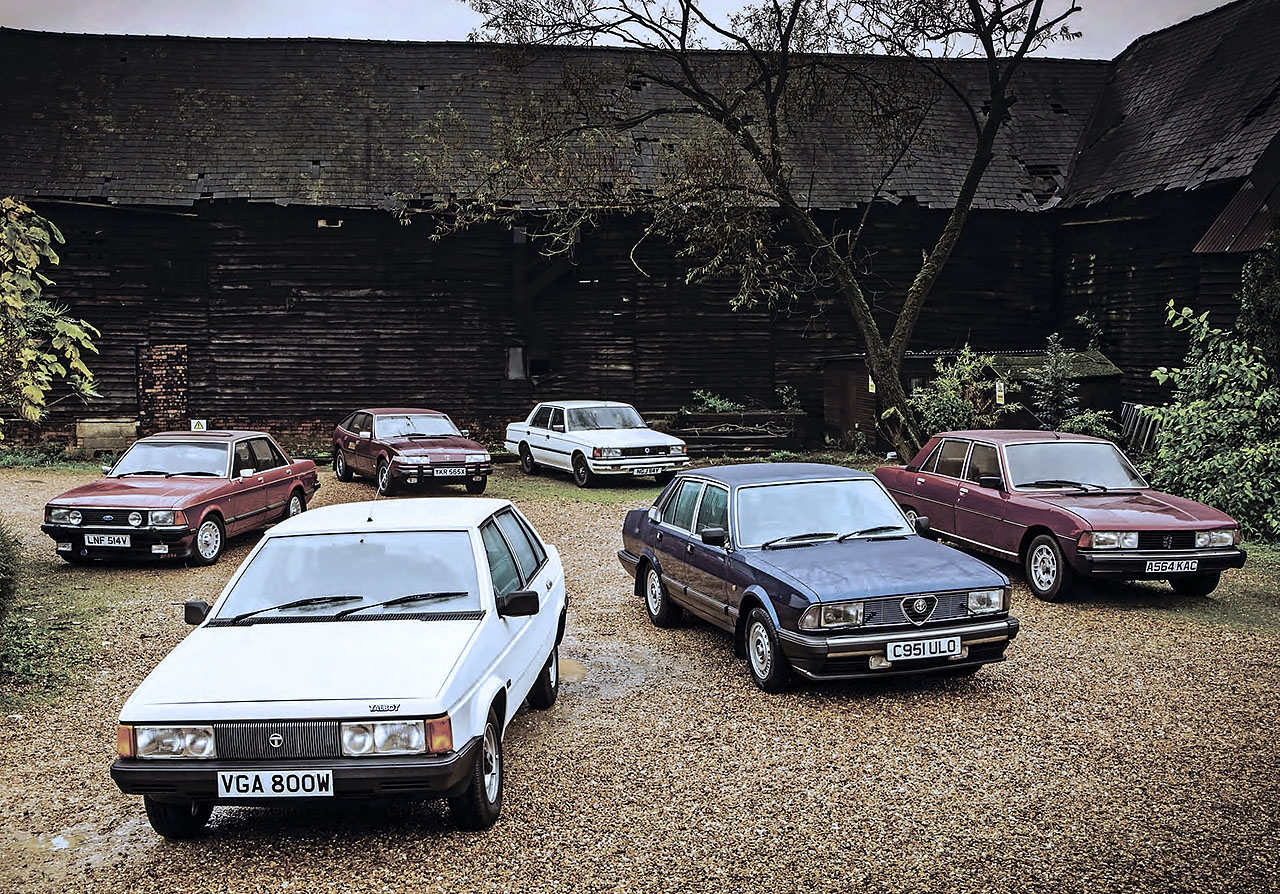
Bargefest! Six big executive saloons do battle ’80s style. Battle of the BARGE III. The Velour Goldmine. Having sampled the choice luxury saloons from the 1960s and ’70s, Martin Buckley focuses on the ’80s with six rare survivors from the 2m sold that decade. Photography Tony Baker.
The barge looked as if it might have had its day as the 1980s dawned. When reduced crude oil supplies from post-revolution Iran triggered the second fuel crisis in 1979, the UK price of a gallon of 4-star broke the £1 barrier for the first time the following year. Suddenly a man who earned £8000 a year was looking at a £1000 per annum fuel bill for the dubious privilege of driving his thirsty, buttonedvelour status symbol. Although Peugeot had pioneered turbo-diesel technology in the 604, today’s fast and refined executive oil-burning big saloons were years away; barge ownership circa 1980 still meant 20mpg at best.
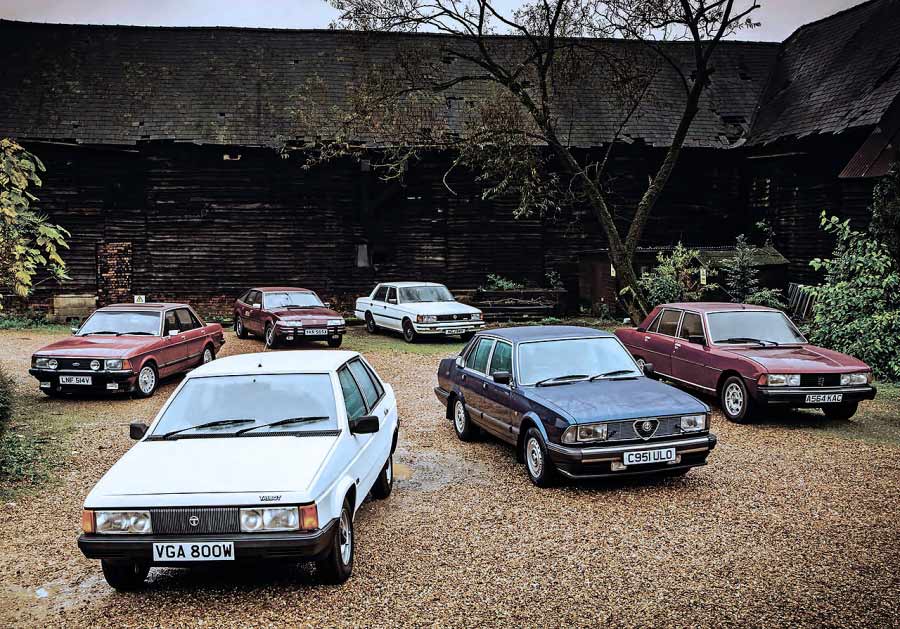
It should never be forgotten that business users were a huge driver in the way that these cars were conceived and marketed. Relatively few large saloons were purchased new by private individuals who found it hard to stomach the financial kick in the groin when the time came to trade in. By the early 1980s, in fact, nine out of every 10 Ford Granadas were bought by companies. More than ever, the big-car landscape of that time was about the requirements of fleet managers and the baffling world of tax break points and ‘perks’. Margaret Thatcher and Geoffrey Howe put the mockers on the situation with new legislation in 1982. It was announced in that year’s budget that company car users faced a 50% increase in the tax bills relating to their vehicles and the fuel that they consumed.
Big cars were suddenly showroom poison and the market for them shrank by 12% in Europe. That accounted for almost 400,000 lost sales as many buyers downsized to thriftier vehicles. Even so, the region’s appetite for traditional large saloons had not quite disappeared altogether – which was just as well because there were several new models in the pipeline that had too much industrial and corporate momentum behind them to be cancelled.
Then (as now, probably) manufacturers liked flogging us big cars because the profit margins were commensurately greater. It doesn’t cost much more to make a lardy saloon than it does a nifty runabout, but you can certainly charge a lot more money for all that extra sheet steel. Two million buyers still felt that they ‘needed’ a luxury tintop for its space, its comfort and its perceived prestige in the company car park. Here we evaluate six ways the bargemiesters of the ’80s spent their money.
Ford Granada 2.8i Ghia
The Granada represented the exact piece of big car sales action everyone else wanted to muscle in on. It succeeded where others failed, not because it offered any blinding technical revelations or insights, but because it was a thoroughly marketresearched and properly engineered product.
From 2-litre poverty models via 2.3 and 2.8 V6s to the plush and pokey 2.8 injection Ghia, the second generation of Granada boasted a range that was finely tuned to buyers’ expectations and progressed in neat calibrations of price, trim and performance. Uwe Bansen’s crisply defined three-box shape – launched in 1977 – has aged remarkably well, particularly in original form. Today, any elderly Granada is the sort of bluecollar classic that tends only to impress men in white vans; somehow they press nostalgic buttons with a predominantly white male working class grassroots constituency.
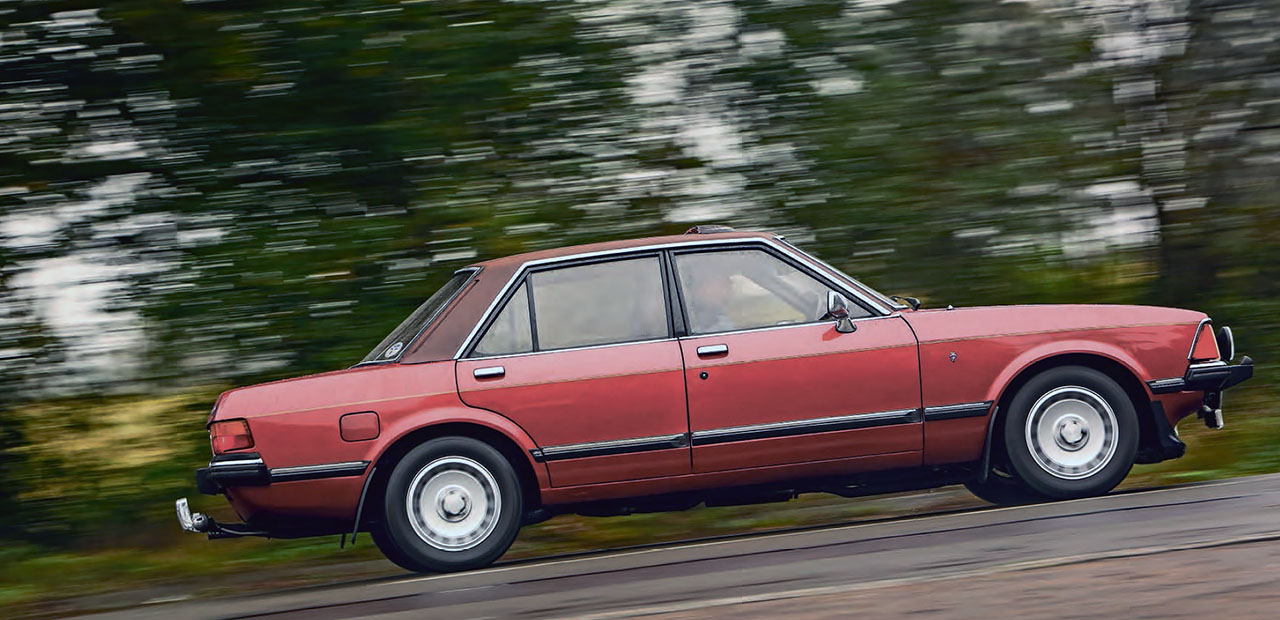
If you spool back 30 years, though, the Mk2 Granada Ghia was a seriously swish and sophisticated machine that could square up to any 5 Series BMW. Most people knew that it was made in Germany, so it seemed immune from the strike-ravaged image of its British competitors. No excuses had to be made for any aspect of its finish or for the way that it drove.
You can still sense that competence in this 1980 example. It sits well on the metric (and now viciously expensive) Michelin TRX tyres that were part of the Ghia package. These were hot news at the time and bestowed above average grip on the always well-mannered Granada. It aspired to standards of driver appeal set by the likes of BMW and Mercedes, although it was priced against top-end Renaults and V8 Rovers. Its pushrod-operated tappets click and clack at tickover in a not very aristocratic way, but the Bosch injection gives it perfect drivability via the C3 automatic ’box. Inside, the Ghia spec meant crushed velour and simulated veneer, which sounds cheesier than it really is. The optional leather (as here) is classier still. In fact, the clear instruments were a lesson in how it should be done and goodies such as powered, tinted windows, a tilt-and-slide sunroof, headlamp washers and remote-control door mirrors were enough to turn the neighbours green.
‘THE GRANADA WAS A SERIOUSLY SWISH MACHINE THAT COULD SQUARE UP TO ANY 5 SERIES BMW’

Well-appointed Ghia Ford offered lots of spec for the money; plenty of room in the back; Cologne V6 weighs c50lb less than Essex; superb ergonomics.
Alfa-Romeo Alfa 6
The Alfa 6 is up there with the Talbot Tagora as one of the great, almost-mythological beasts of the barge world. It’s one of those cars that just makes you ask yourself ‘why?’
Designed in the late 1960s for a projected launch in 1973/1974, the 6 was elbowed out of the schedule – quite rightly – by the much more commercially important Alfetta, with which it shared its doors and basic floorpan, although not its rear-mounted gearbox. The launch was delayed until 1979, by which time the world was well into yet another oil crisis and had in any case moved on from this school of formal, angular styling. Alfa Romeo’s priceless excuse for the way the 6 looked was that it wanted to build a car that didn’t attract too much attention from the kidnappers, terrorists and other assorted bandits that were abroad in Italy at the time.
Unfortunately, it didn’t attract much attention from anyone, least of all potential buyers in the UK, which should have been a good market. Only 134 were imported through to the model’s demise in 1986. This is the only MoT’d Series 2 example currently on the road in these islands. Series 2 means fuel injection, square headlights and a few other tweaks in an 1982 makeover by Bertone; the earlier cars had four circular lamps and a famously difficult to tune six carburettor set-up. Not even the availability, in the left-hand-drive market, of a five-cylinder diesel and 2-litre version of the petrol V6 could do much for sales, which totalled 12,070 cars. The 6, however, makes a much better classic than it ever did a serious executive contender. Its saving grace remains the wonderful engine that sounds much stronger than its 156bhp, yet is also marvellously refined – a cultured V6 compared to the Granada’s workmanlike unit.
The 6’s reputation as a sales dud obscures the fact that it was a capable car worthy of the Alfa reputation. It steers, stops and rides with most of the alacrity of the agile Alfetta. The power steering is BMW-like in its swift and clean responses and the ride is similarly reassuring in its lack of wallow. Inside, it feels narrow for its length (a corollary of its Alfetta roots), but the cabin is possessed of a boxy elegance that is wrought in quite classy materials. For a 1980s Italian car, you’d have to say that it feels pretty nicely made.
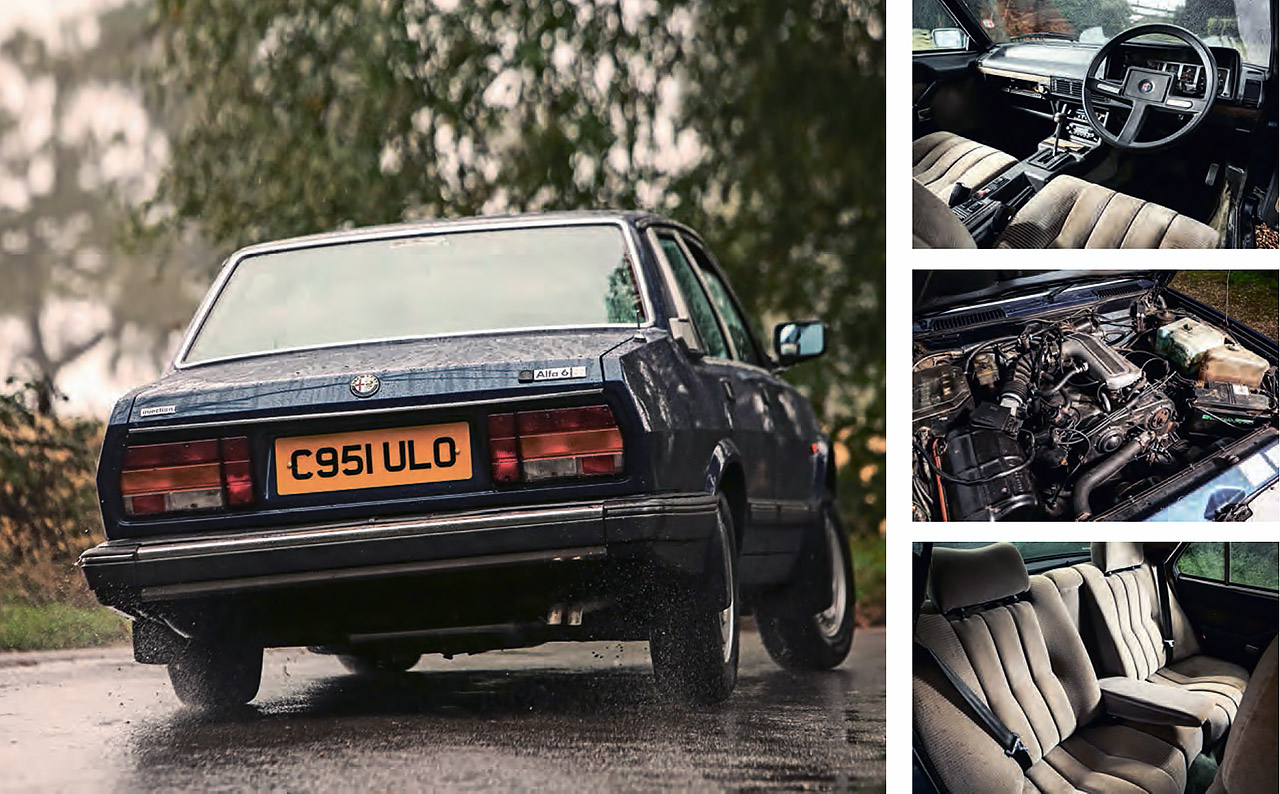
Super-rare 6 grips and handles well; squarerigger theme continues on the inside, with wheel boss and instruments; sweetrevving V6; posh velour.
Toyota Crown Super Saloon
Most European buyers probably rejected the Toyota Crown out of hand on the basis of what it looked like rather than how it drove.
Although descended from a long line of wobbly and ornately detailed saloons built for conservative Japanese business people, this seventh-generation version – with its fuelinjected, straight-six engine and four-speed automatic transmission – was a better car than it appeared, which maybe isn’t saying much.
There are certain clumsily executed references to Mercedes W116 S-class styling, but the Crown remains determinedly mid-Pacific in its overall shape. It was the product of an entirely separate cultural sensibility that either had not yet grasped what it took to woo Western big-car buyers or was more interested in keeping its enthusiastic home-market happy.
Despite being about as heavy as the competition, the Crown sweeps away enthusiastically when you level the throttle – 0-60mph took just over 10 secs – or will glide effortlessly in its long overdrive top gear that allows 114mph flat out and 25mpg cruising within the legal limit. The recirculating-ball power steering is speed sensitive and, while it cannot entirely disguise the limitations of this nose-heavy understeering vehicle, you can get along swiftly enough in the Toyota without losing your dignity.
The interior is a cheese-fest of unappealing synthetic materials styled with maximum fuss in a way that only the Japanese could. And yet, if you look beyond the chintz, there are lots of impressive touches such as full air-conditioning, a coolbox in the rear parcel shelf, electric remotecontrol door mirrors and all kinds of other conveniences (all standard) that we now take for granted, but which were rare in the early ’80s. The Crown is also unique here in the way that it focuses on the needs of rear-seat passengers, who even have their own overriding controls for the radio and aircon. Is it perhaps the car for the penny-pinching tycoon who preferred to be chauffeured rather than to drive himself?
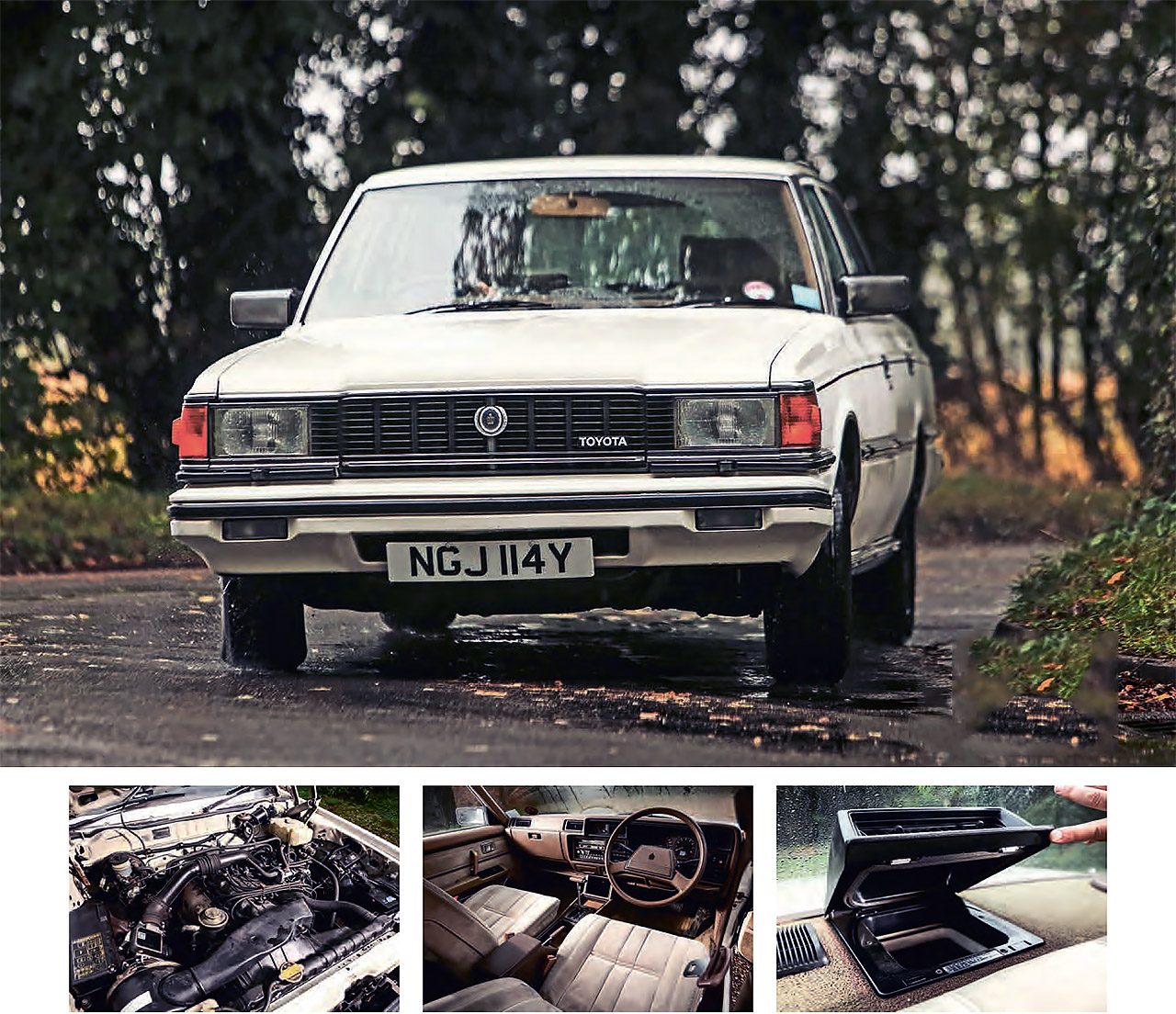
Short-lived Toyota sold well, but not in Europe; smooth ‘six’ is quite lively; cloth trim, plus vast array of kit that even includes aircon and fridge in back!
Rover 3500 Vanden Plas
The SD1 3500 is a tragic remnant of Leyland’s malignant influence over the once noble house of Rover. We all know that Allegros and Marinas were tat, but this is a car that reeks of unfulfilled ambition, its early promise as a new performance- and-efficiency orientated Euro-Rover for the second half of the ’70s reduced to near-joke status by the dawn of the following decade.
By then, Rover was trying to rescue the model’s reputation for abysmal quality and reliability via reassuring new variants such as this flagship Vanden Plas with its full Connolly leather interior, machined alloy wheels, headlamp wash/ wipe, as well as powered sunroof and mirrors.
Supplementing the 3500SE (and in effect replacing the 3500S), it was a vehicle that still cut a striking figure on British roads, with its chisel nose and practical hatchback, although the ‘fourdoor Daytona’ comparisons are perhaps a little flattering. That said, it made a brilliant racer.
‘AS YOU SIT LOW, ADMIRING THE FUTURISTIC DASH POD, IT FEELS TOO ALERTTO BE A TRUE BARGE’
The rationale behind the new Rover was to go back to basics and build a saloon along simple lines (so that it was easier to produce and service), but refine the details. Hence the return to a live – but self-levelling and well-located – rear axle after the relatively exotic de Dion set-up of the P6. If it didn’t ride as well as the earlier model, then the handling trade-off was probably worth it – especially because the power steering was so highly geared and precise.
By making it long-legged and relatively aerodynamic – things nobody was talking about much in 1976 – Spen King and his team made the best out of the sweet, punchy V8 engine.
As you sit low, admiring David Bache’s futuristic instrument pod, a sorted SD1 feels too alert and together to be a true barge. It is stable, swift and firmly resistant to body roll. Five-speed manuals are fun, but the automatic that came as standard in the VdP is relaxing while somehow managing to retain the high gearing that still makes a nice SD1 V8 a pleasant motorway car. In fact, for the price, the SD1 was as good as anything in its class and much of its poor reputation centres around the camshaft-snapping and head-gasket popping frailties of the 2300/2600 variants rather than the all-alloy V8. Now, as then, it is the best thing about the car.
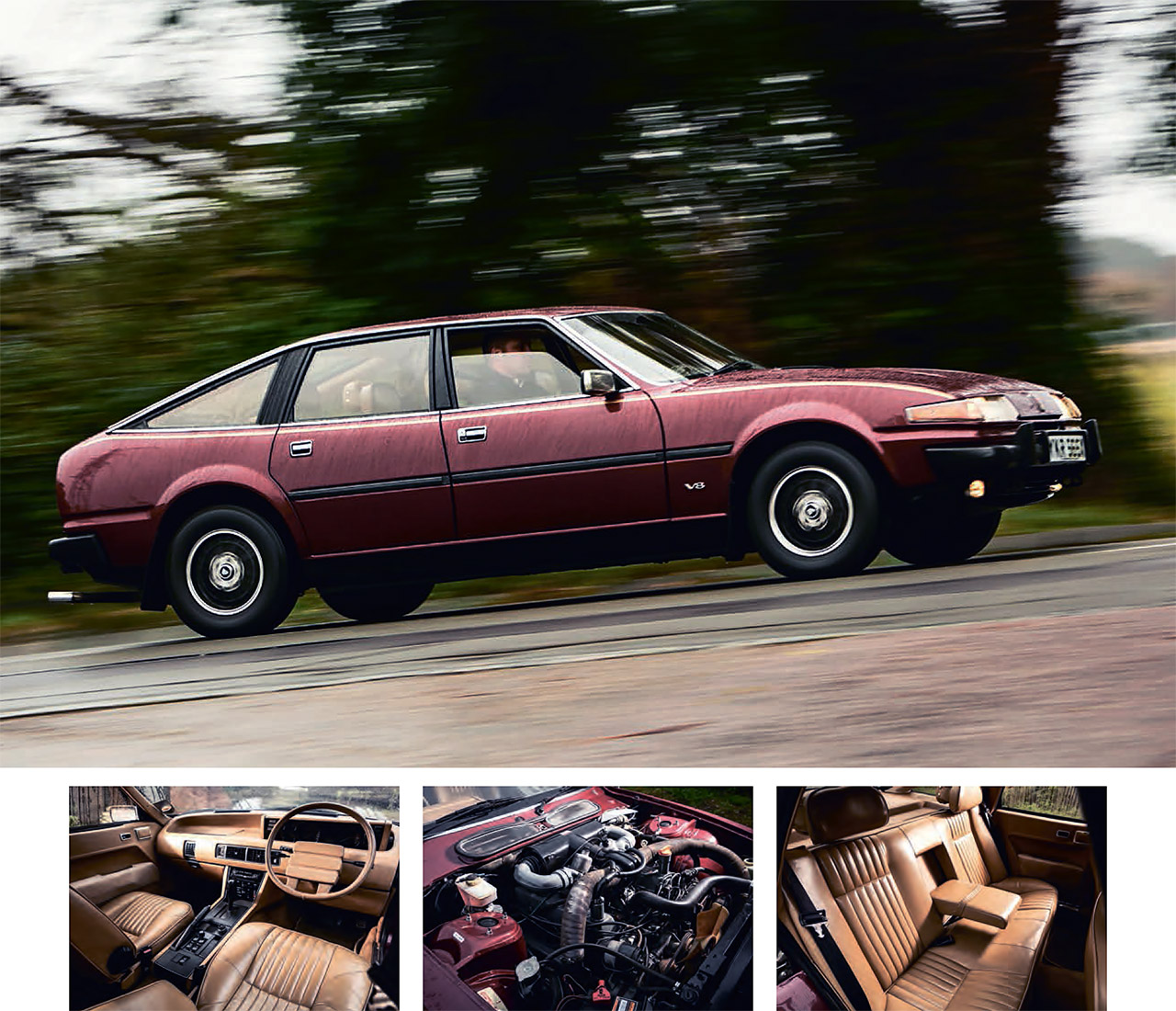
First car from Specialist Division No1 is unique here as a hatchback; hide trim in VdP; Buick-derived V8; clever dash design for left- or right-hand drive.
Peugeot 604 STI
The 604 was Peugeot’s belated return to the bigcar field, although it already had a reputation for making some of the world’s best-riding midrange saloons. The handsome Pininfarina-styled tintop enhanced the firm’s reputation for making conservative but refined middle-class machinery. The shape doesn’t grab everybody, although I find it a mature and quietly elegant profile with an appealing chunky tail and large, squarely shaped doors that open enormously wide. It was a shoe-in for ministerial duties, taking over from the DS as the ‘official’ French Government car.
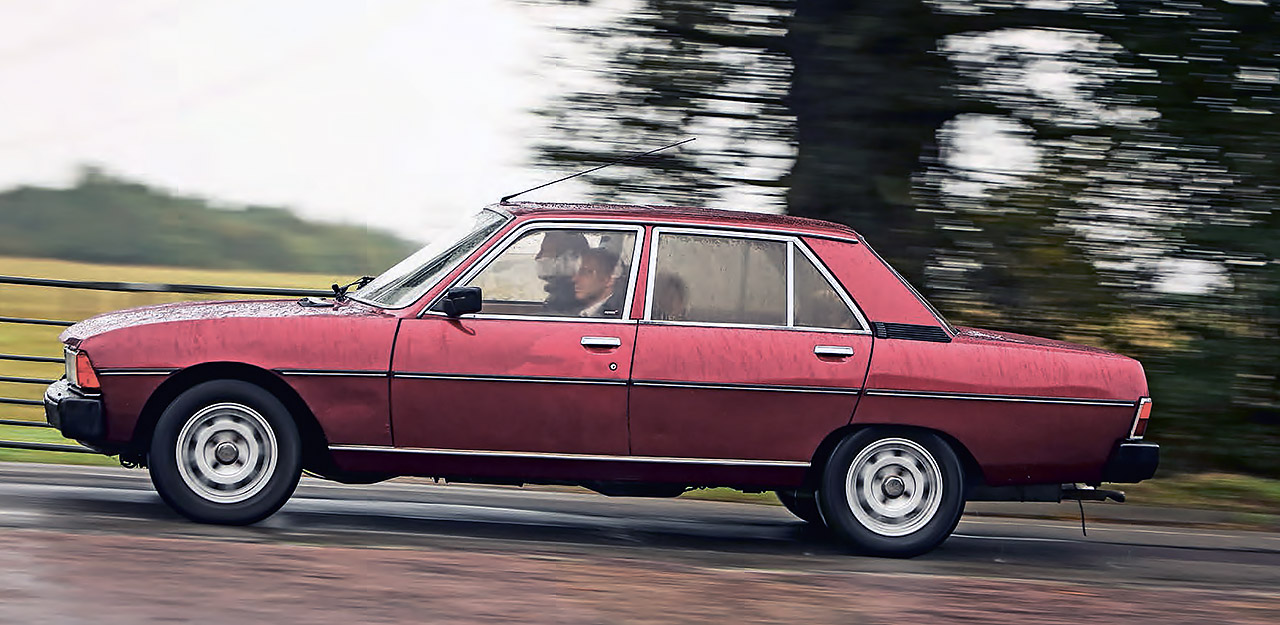
The Peugeot 604 STI is a saloon with just enough of everything to keep you satisfied without being particularly astonishing. Its slightly lumpy, wideangle fuel-injected Peugeot-Renault-Volvo V6 engine (originally planned as a V8 and later to find a home in the Talbot Tagora) lacks either the muscle of the Rover or the exotic appeal of the Alfa. Yet it is quantifiably more impressive than the thrashy Cologne V6 in the Granada or the somewhat characterless Toyota engine.
Head for a corner and the 604 rolls rather more than the Rover or the Ford (and more than modern drivers would feel comfortable with), although it seems to hang on for ever on its Michelin TRX tyres. Your way is plotted by notably accurate power steering and a general determination not to be knocked off line.
‘ONLY THE JAGUAR XJ OUTSHONE ITS ABILITY TO DEAL WITH ALL KINDS OF POOR SURFACES’
It feels bright inside, the view out commanding from wonderfully soft seats. With its generous rear leg, head and shoulder room – plus its massive boot – the 604 was, and remains, an outstanding long-distance touring machine.
But the best thing about the car is its ride. By the time that Peugeot killed off the 604 in the mid-’80s, it still offered a level of sophistication – in terms of civilisation and comfort – that was beyond even the expectations of this class of car. Probably only the Jaguar XJ outshone its ability to deal with all kinds of poor roads. Even now it is hard to think of a modern car that rides with such a light touch. The 604, no matter what the surface, never feels as if it is raising a sweat.

Understated 604 has best ride here; plush velour, plus fine ergonomics; PRV V6 gained fuel injection from ’78; 604 also came with turbo-diesel ‘fours’.
Talbot Tagora GL
Conceived in the mid-’70s as a successor to the 180/2 litre, the C9/Tagora project was too far into development to be cancelled when Peugeot took over Chrysler Europe in 1979. With its newly inherited Sunbeam/Alpine ranges swiftly rebadged as Talbots, the nascent Tagora of 1980 was the first new model under the PSA regime.
It was far more than a tweaked Peugeot under those angular lines; the 604/505 suspension was simply a last-minute PSA modification aimed at giving this orphan barge some family kinship. Of the handful of Tagoras still alive in the UK, this is the only base-model GL known to survive. That means just four manual speeds to harness its 115bhp and no power steering, although it was an option. It feels austere and brittle in its fittings, but airy and spacious with clear dashboard architecture and no attempt at wood appliqué.
The V6 SX was quick, with a good power-toweight ratio, but the 2.2-litre ‘four’ is a hesitant, gasping presence that urges the car along with no sense of enthusiasm and hardly seems worthy of what was a supple, sophisticated and surefooted chassis. It is rather flavourless to drive once you’ve overcome the thrill of being at the wheel of a car that is so close to extinction.
The Tagora’s shape was signed off by Roy Axe in Coventry as early as 1976. It might have fared better had it appeared then, but production didn’t begin at the old Simca Poissy plant until 1980. It was all over by 1983, with just 23,400 built. The Tagora wasn’t a bad car, just a bit pointless in that it didn’t offer anything over the competition.
Compared to their earlier counterparts, I can’t help feeling that our ’80s barges have survived less well – their ranks thinned by rust, bangering and an apathy born of plummeting desirability in a world that values only prestige ‘brands’.
Lucky for us that every car has someone to love it in its old age even if, like the Tagora, it was born into the world with the odds stacked against it. It is sobering to think that – from being relatively commonplace 25 years ago – many of these cars are now among the rarest on the UK’s roads.
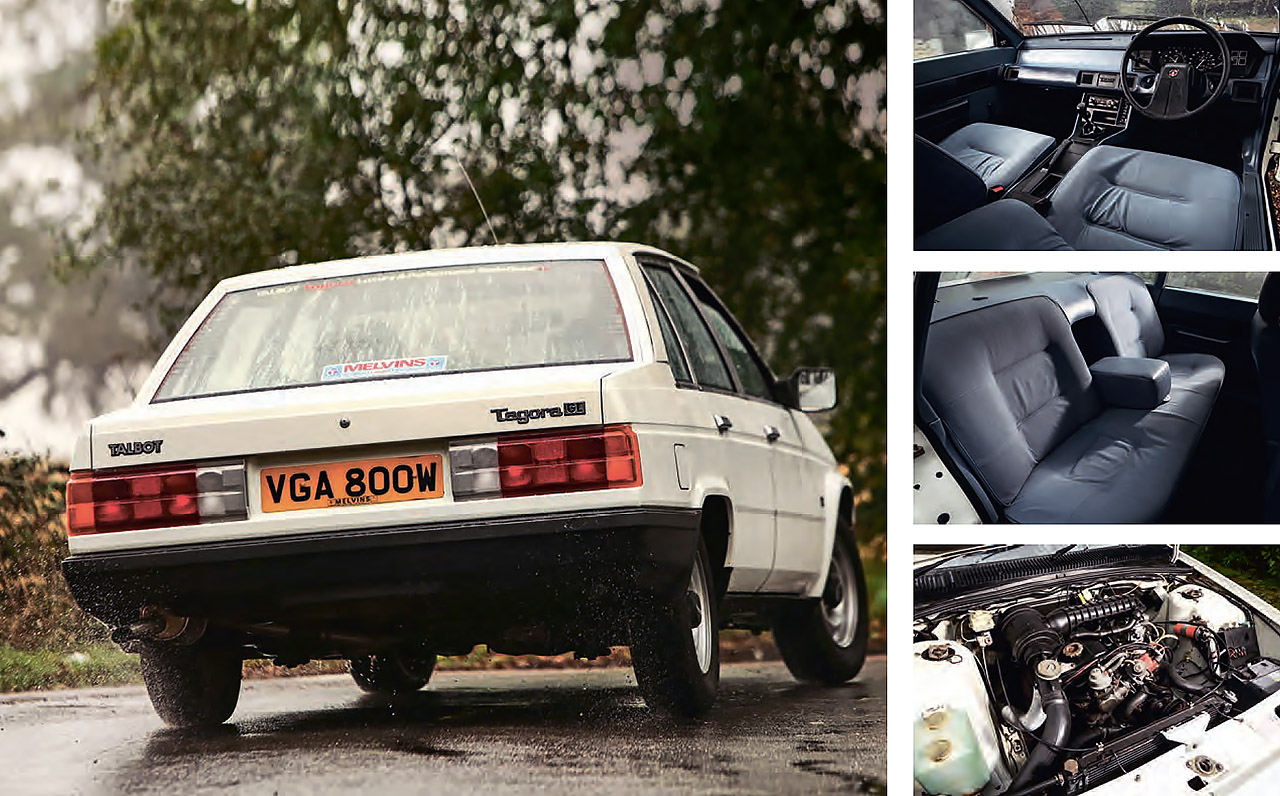
Immaculate, 17,000-mile ex-dealer demo model is the only GL known in UK; hints of Alpine in spacious cabin; 604 underpinnings but lean better controlled.
| Car | Ford Granada 2.8i Ghia | Alfa 6 | Toyota Crown Super Saloon | Rover 3500 Vanden Plas | Peugeot 604 STI | Talbot Tagora GL |
|
Sold Number built |
1977-1985 639,440 |
1980-1986 12,070 |
1980-1983 823,000 |
1976-1986 303,343 (all models) |
1975-1985 240,100 |
1981-1984 23,400 (all) |
| Construction | stell body | |||||
| Engine |
all-iron ohv 2792cc V6 |
all-alloy sohc-per-bank 2492cc V6 |
iron-block alloy-head sohc 2759cc straight-six |
all-alloy ohv 3528cc V8 |
all-alloy sohc-per-bank 2664cc V6 |
all-alloy sohc 2155cc ‘four’ |
| Max power | 160bhp @ 5700rpm | 158bhp @ 5600rpm | 145bhp @ 5500rpm | 155bhp @ 5250rpm | 144bhp @ 5500rpm | 115bhp @ 5400rpm |
| Max torque | 162lb ft @ 4300rpm | 156lb ft @ 4000rpm | 123lb ft @ 4000rpm | 198lb ft @ 2500rpm | 159lb ft @ 3750rpm | 133Ib ft @ 3200rpm |
| Transmission | Ford C3 automatic | ZF 3HP three-speed auto |
five-speed manual or four-speed |
three-speed Borg-Warner |
five-speed manual or threespeed |
four/five-speed manual or three-speed automatic |
| Drive | RWD | RWD | RWD | RWD | RWD | |
| Suspension: | ||||||
| front | double wishbones |
double wishbones, torsion bars |
double wishbones | MacPherson struts | MacPherson struts | MacPherson struts |
| rear | semi-trailing arms; coil springs f/r | de Dion axle, coil springs | live axle; coil springs f/r | live axle, coil springs | semi-trailing arms, coil springs | semi-trailing arms, coil springs |
| Steering | ||||||
| Brakes | ||||||
| Wheels | ||||||
| Length | ||||||
| Width | ||||||
| Height | ||||||
| Wheelbase | ||||||
| Weight | 3100lb (1406kg) | 3241lb (1470kg) | 3164lb (1435kg) | 3097lb (1405kg) | 3252lb (1475kg) | 2767Ib (1255kg) |
| 0-62mph | 8.9 secs | 11 secs | 10.4 secs | 9.1 secs | 9.4 secs | 11.3 secs |
| Top speed | 117mph | 115mph | 114mph | 122mph | 115mph | 106mph |
| Mpg | 24 | 22 | 21 | 20 | 24 | 29 |
| Price new | £9615 | £11,900 | £8650 | £9200 | £8522 | £7000 |
| Value now |
£3000 Thanks to owner Phil Bosher |
£4000 Thanks to owner Chris Cousins |
£3000 Thanks to owner Greg Horrocks |
£4000 Thanks to owner Chris Parmenter |
£3000 Thanks to owner Gareth Davies |
£3000 Thanks to owner Tony Owen |
{CONTENTPOLL [“id”: 20]}





